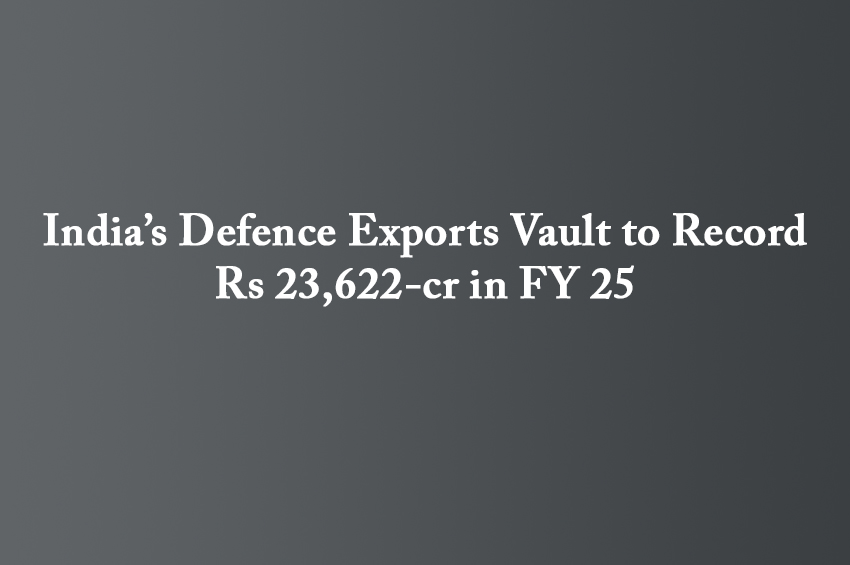Winning Bizness Economic Desk
The country’s defence exports have vaulted to a record Rs 23,622-crore in FY 25, reflecting a memorable milestone in its pursuit of self-reliance under the Atmanirbhar Bharat initiative.
The amount in dollar terms works out to approximately USD 2.76-billion.
This achievement signifies a 12.04 per cent increase over the previous fiscal year’s exports of Rs 21,083-crore and an astounding 34-fold vault compared to the Rs 686-crore registered in 2013-14.
The point that requires highlighting here is that this exponential growth underscores the country’s expanding capabilities and prominence in the global defence manufacturing capabilities.
The big jump in exports is attributed to the collaborative efforts of over 100 companies including Public Sector Units (PSUs) such as Hindustan Aeronautics Limited (HAL), Bharat Electronics Limited (BEL) and Bharat Dynamics Limited (BDL), along side private sector majors such as L&T, Tata Advanced Systems and Bharat Forge.
India’s defence export portfolio encompasses a diverse range of products including missile systems such as the BrahMos and Akash, artillery guns such as the Advanced Towed Artillery Gun System (ATAGS), radars, electronic warfare systems and various platforms such as the Dornier-228 aircraft.
Its strategic partnerships and defence agreements have facilitated exports to over 85 countries, enhancing its global footprint in the defence sector.
Net Direct Tax Collection in FY 25 Touches Rs 22.26-trillion
The provisional net direct tax collection for FY 25 slid marginally to Rs 22.26-trillion, falling short of the revised government-set target of Rs 22.37-trillion announced in the Budget in February.
The net direct tax collection in FY 24 was Rs 19.60-trillion.
The marginal decline in the collections was on the back of a decrease in the collection of `other taxes’ while corporate and non-corporate tax collections were almost on the mark.
These direct tax collection figures are provisional and collections are expected to grow as last stage reconciliation and adjustment for FY 25 are still underway, officials were quoted in the media as saying.
The gross direct tax collections (before refunds) during the financial year expanded 15.59 per cent to Rs 27.03-trillion while refunds increased 26.04 per cent to Rs 4.77-trillion.
A point that requires highlighting here is that the tax department issued the highest-ever refunds worth Rs 4.76-trillion during the year, which is an increase of 26.04 per cent compared to the refunds of Rs 3.78-trillion issued during FY 24.
Of net direct tax collections, non-corporate tax grew 17 per cent Year-on-Year (YoY) to Rs 11.8-trillion. In the last fiscal (FY 25), corporate tax climbed up at a slower pace of 8.3 per cent to Rs 9.87-trillion.
The Securities Tax Transaction (STT) grew 55.87 per cent to Rs 53,296-crore.
Gross tax collection figures for corporate tax stood at Rs 12.72-trillion, an increase of 12.41 per cent over the preceding year.
India’s Retail Inflation Declines to 3.16 pc
India’s retail inflation has slipped to its lowest in nearly six-years with cooling vegetable prices leading the slide. It fell to 3.16 per cent in April of this year from the 3.34 per cent of the previous month (March), data from the Ministry of Statistics and Programme Implementation (MoSPI) showed.
This, it must be pointed out, is the lowest inflation reading since July 2019.
Food and beverages inflation eased to 2.14 per cent from the 2.88 per cent in March while vegetables inflation contracted by 10.98 per cent after contracting by 7.04 per cent in March.
Encouraging prospects for agriculture production, arrivals of fresh rabi harvest and healthy reservoir levels are positives for food inflation.
The India Meteorological Department (IMD)’s projection of an above-normal monsoon should strongly support the agriculture sector.
However, monitoring the monsoon’s distributional aspect will be crucial.
Edible oils prices remain a key concern, especially given the contraction in the sowing of oil seeds, an increase in global edible oils prices and import dependency in this category.
Cereal prices rose by 5.35 per cent after rising by 5.93 per cent in March while meat and fish prices moved southward 0.35 per cent as compared to a rise of 0.32 per cent in the previous month.
Inflation rate for milk and milk products stood at 2.72 per cent as compared to 2.56 per cent in the previous month. A point to note here is that inflation in pulses category contracted by 5.23 per cent after contracting by 2.73 per cent last month.
Clothing inflation dipped at 2.67 per cent as against 2.71 per cent in the preceding month while housing prices increased by three per cent as compared to 3.03 per cent last month.
Fuel and light inflation also moved northward at 2.92 per cent as compared to 1.48 per cent in March.
Going ahead, the Consumer Price Index (CPI)-based inflation is projected to stay at comfortable levels, supported by moderating food inflation, despite headwinds from trade policy uncertainties and geo-political tensions.
India’s Gem and Jewellery Exports Decline by 4.62 pc in April
The country’s overall gems and jewellery exports slipped by 4.62 per cent to USD 2,037.06-million in April as compared to the same month of the previous financial year, according to the Gem and Jewellery Export Promotion Council (GJEPC).
The country’s total gems and jewellery exports stood at USD 2,135.7-million in the same month of the previous year, the GJEPC data showed.
The overall export of `Cut and Polished’ diamonds slipped by 6.12 per cent to USD 1,108-.74-million in April, compared to 1,180.99-million in the same year-ago period.
A point to be noted here is that the total shipment of gold jewellery witnessed a dip of 5.41 per cent at USD 684.51-million during the month under review, as compared to USD 723.63-million for the same period of the previous year.
Gross export of `Polished Lab Grown Diamonds’ in April was almost flat with a growth of just 0.41 per cent at USD 110.74-million over the USD 110.29-million in the same month of the last fiscal (FY 25).
Silver jewellery exports in April too declined by 12.03 per cent at USD 38.3-million. However, exports of `Coloured Gemstones’ registered a growth of 11.95 per cent at USD 22.76-million, as compared to the USD 24.8-million in the same period of the previous year.
India’s Foreign Exchange Reserves Increase to USD 690-billion
India’s foreign exchange reserves increased to USD 690.61-billion for the week ended May 9 of this year. The northward climb was primarily fuelled by an increase in gold holdings.
This marks a rise of USD 4.553-billion when compared to the previous reporting week, according to data from the Reserve Bank of India (RBI).
Here, it must be pointed out that the country’s forex kitty had slipped by USD 2-billion in the preceding seven days, standing at USD 686-billion for the week ended May 2.
What requires highlighting here is that India’s forex holdings are the fourth largest after China, Japan and Switzerland.
The reserves had steadily risen after a steep slide from their peak of USD 700-billion at end-September.
Besides, foreign investors have pulled out nearly USD 9-billion from the country’s debt and equity markets for this year, according to data from the National Securities Depository Ltd.
For the week ended May 9, Foreign Currency Assets (FCAs), a major component of the reserves climbed up to USD 581-billion, according to India’s apex bank, the RBI data showed.
In dollar terms, the FCAs include the effect of the appreciation or depreciation of non-US units like the Euro, Pound and Yen held in the foreign reserves.
An important point to be noted here is that gold reserves increased by USD 4.5-billion to USD 86.3-billion during the week.


